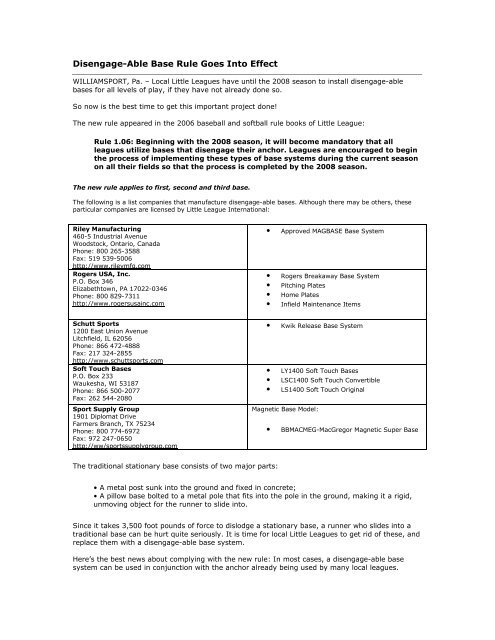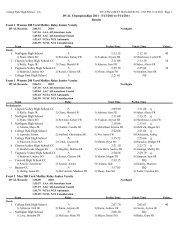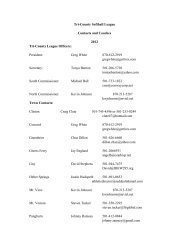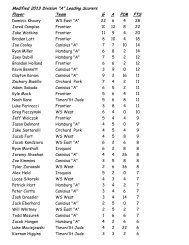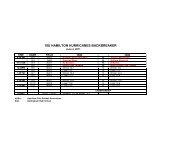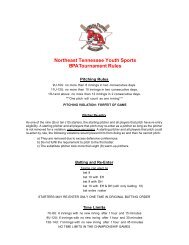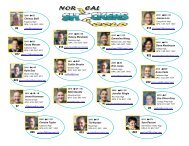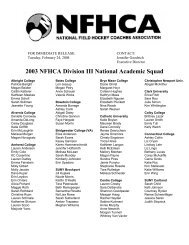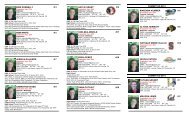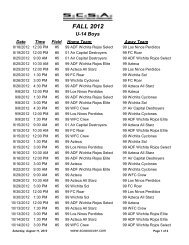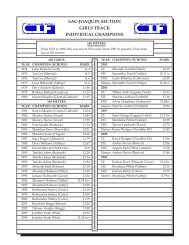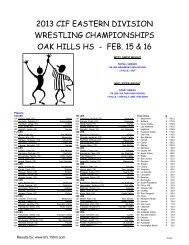Disengage-Able Base Rule Goes Into Effect - Eteamz
Disengage-Able Base Rule Goes Into Effect - Eteamz
Disengage-Able Base Rule Goes Into Effect - Eteamz
Create successful ePaper yourself
Turn your PDF publications into a flip-book with our unique Google optimized e-Paper software.
<strong>Disengage</strong>-<strong>Able</strong> <strong>Base</strong> <strong>Rule</strong> <strong>Goes</strong> <strong>Into</strong> <strong>Effect</strong><br />
WILLIAMSPORT, Pa. – Local Little Leagues have until the 2008 season to install disengage-able<br />
bases for all levels of play, if they have not already done so.<br />
So now is the best time to get this important project done!<br />
The new rule appeared in the 2006 baseball and softball rule books of Little League:<br />
<strong>Rule</strong> 1.06: Beginning with the 2008 season, it will become mandatory that all<br />
leagues utilize bases that disengage their anchor. Leagues are encouraged to begin<br />
the process of implementing these types of base systems during the current season<br />
on all their fields so that the process is completed by the 2008 season.<br />
The new rule applies to first, second and third base.<br />
The following is a list companies that manufacture disengage-able bases. Although there may be others, these<br />
particular companies are licensed by Little League International:<br />
Riley Manufacturing<br />
460-5 Industrial Avenue<br />
Woodstock, Ontario, Canada<br />
Phone: 800 265-3588<br />
Fax: 519 539-5006<br />
http://www.rileymfg.com<br />
Rogers USA, Inc.<br />
P.O. Box 346<br />
Elizabethtown, PA 17022-0346<br />
Phone: 800 829-7311<br />
http://www.rogersusainc.com<br />
Schutt Sports<br />
1200 East Union Avenue<br />
Litchfield, IL 62056<br />
Phone: 866 472-4888<br />
Fax: 217 324-2855<br />
http://www.schuttsports.com<br />
Soft Touch <strong>Base</strong>s<br />
P.O. Box 233<br />
Waukesha, WI 53187<br />
Phone: 866 500-2077<br />
Fax: 262 544-2080<br />
Sport Supply Group<br />
1901 Diplomat Drive<br />
Farmers Branch, TX 75234<br />
Phone: 800 774-6972<br />
Fax: 972 247-0650<br />
http://ww/sportssupplygroup.com<br />
The traditional stationary base consists of two major parts:<br />
• Approved MAGBASE <strong>Base</strong> System<br />
• Rogers Breakaway <strong>Base</strong> System<br />
• Pitching Plates<br />
• Home Plates<br />
• Infield Maintenance Items<br />
• Kwik Release <strong>Base</strong> System<br />
• LY1400 Soft Touch <strong>Base</strong>s<br />
• LSC1400 Soft Touch Convertible<br />
• LS1400 Soft Touch Original<br />
Magnetic <strong>Base</strong> Model:<br />
• BBMACMEG-MacGregor Magnetic Super <strong>Base</strong><br />
• A metal post sunk into the ground and fixed in concrete;<br />
• A pillow base bolted to a metal pole that fits into the pole in the ground, making it a rigid,<br />
unmoving object for the runner to slide into.<br />
Since it takes 3,500 foot pounds of force to dislodge a stationary base, a runner who slides into a<br />
traditional base can be hurt quite seriously. It is time for local Little Leagues to get rid of these, and<br />
replace them with a disengage-able base system.<br />
Here’s the best news about complying with the new rule: In most cases, a disengage-able base<br />
system can be used in conjunction with the anchor already being used by many local leagues.
A disengage-able base often consists of three major parts:<br />
• A metal post sunk into the ground and fixed in concrete (just like a traditional system);<br />
• A rubber mat, bolted to a pole that is inserted into the ground (into the existing post, in<br />
most cases);<br />
• A separate pillow that fits onto the rubber mat.<br />
When a runner slides into a disengage-able base, the pillow has the ability to release from the mat<br />
and move with the motion of the runner. But when the disengage-able base is stepped on by a<br />
runner crossing the base, or by a fielder, it will stay in place.<br />
A five year study conducted from 2000 to 2004 showed that 55 percent of injuries to runners occur<br />
while sliding into base, and 47 percent of all injuries to runners result in fractures.<br />
In his book, “The Awakening Surgeon,” Dr. David Janda discusses a two-year study he conducted<br />
comparing injuries sustained on fields using traditional stationary bases versus fields with<br />
disengage-able bases. In the study, 637 games were played on the disengage-able–base field and<br />
635 on the stationary-base field. By the end of the study, 45 players sustained injuries on the<br />
stationary-base field while only two were injured on the fields with disengage-able bases.<br />
The study concluded that, although the disengage-able bases did not prevent all sliding injuries,<br />
they can reduce the number of these injuries.<br />
Installing disengage-able bases on your league’s field is a great way to help make Little League<br />
<strong>Base</strong>ball and Softball safer for the children who participate.<br />
For information on manufacturers of disengage-able bases, please visit<br />
www.littleleague.org/common/equipment/view.asp?cid=5&id=25<br />
Photo No. 1 shows the buried metal post that is standard on many<br />
baseball and softball fields. With the traditional system, the base<br />
(with post attached) is inserted into the post shown. However, that<br />
does not allow the base to “give” when a player slides into it with<br />
excessive force. That’s because the post is unmovable, and usually is<br />
anchored in concrete. The good news is, installing a disengage-able<br />
base in this situation is simple, and requires no digging.
Photo No. 2 shows the standard metal post in the ground, plus the<br />
other two elements of a disengage-able base. At left is the “pillow”<br />
portion of the base. Next to that is the pad, with attached pole, that<br />
fits into the existing post in the ground.<br />
Photo No. 3 shows the pad, placed over the metal post. The post<br />
attached to the bottom of the pad fits into the existing metal post in<br />
the ground. The pad is flush with the ground, which allows a<br />
following runner to be able to tag the “base” when the pillow<br />
becomes dislodged by a preceding runner. The pad includes bumps<br />
and ridges that hold the “pillow” in place when a runner or fielder<br />
tags the base.
Photo No. 4 shows the “pillow” in place over the pad.


